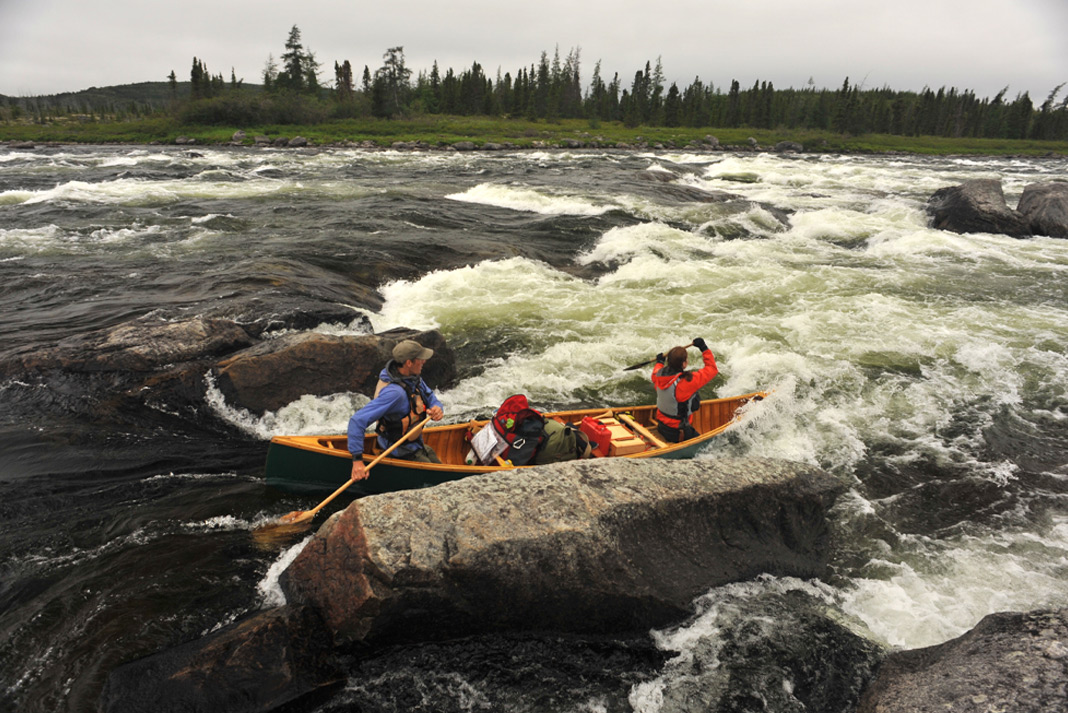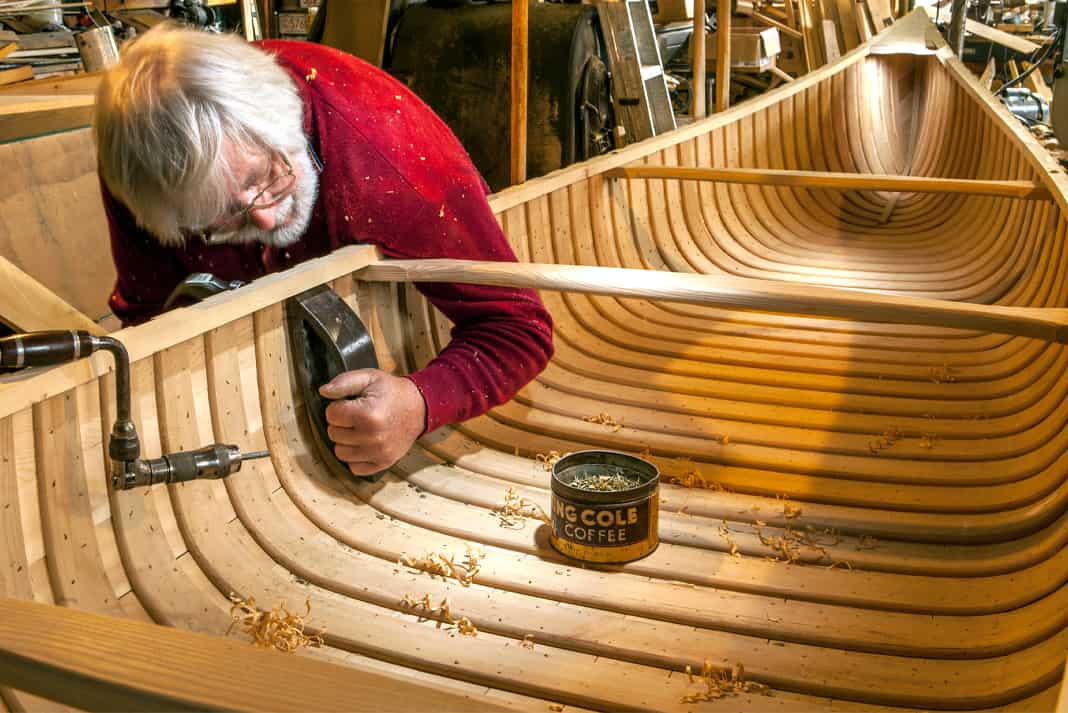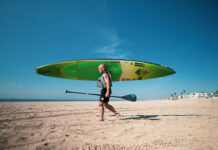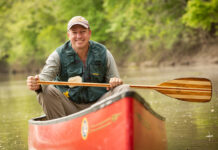There’s more than just a little wickedness in the history of the canoe, and the largest collection of it resides in Grand Rapids, Michigan, in the possession of Ken Kelly. His collection of old-style courting canoes, vehicles of furtive love in a bygone era, fills the rafters of his quaint northern Michigan cottage, garage and the second story of a nearby warehouse.
Kelly is smitten by the old-world charm of wood and canvas canoes, particularly those of the early 20th century—models paddled by men courting women. It was a period full of music, mischief and romance.
Collector Ken Kelly shares his love of antique courting canoes
“The magic for me is the beauty of the wood, the quality of the craftsmanship and the feel of them on the water,” says Kelly, a wine dealer who owns 22 antique canoes in total. His private collection is one of the largest in North America and one of the highest quality collections of courting canoes anywhere in the world.
While Kelly’s boats span nearly 90 years of North American canoe history, most were built for romance and style during the early 1900s, a period when courting your gal in cities like Boston, New York, Detroit and Minneapolis, meant heading out on a moonlit river for a little smooching in the canoe. It was a time when young women let their suitors do the paddling and the canoes were accessorized with phonographs, picnic baskets and pillows, all the better to canoodle with. The ardor of that era began to cool in the 1920s with the advent of the Model T Ford—couples had more options.
“The magic for me is the beauty of the wood, the quality of the craftsmanship and the feel of them on the water.”
Kelly’s favorite canoe of that era is his 1915 Alden Kingsbury, a long-nosed, 16-foot canoe he had meticulously restored. It is one of many designs that originated on the Charles River during a period when canoe builders competed for public attention; a time when “social canoeing” was popular recreation and area boat houses rented to couples for an afternoon or evening.
“It’s stylish and fast, and when I heel it over in the traditional Canadian style, it has a sweet spot and becomes very stable. It’s a slippery design that I like to paddle solo,” says Kelly. The 58-year-old is also the president of the Wooden Canoe Heritage Association, a non-profit group with 1,650 members across North America and Europe.
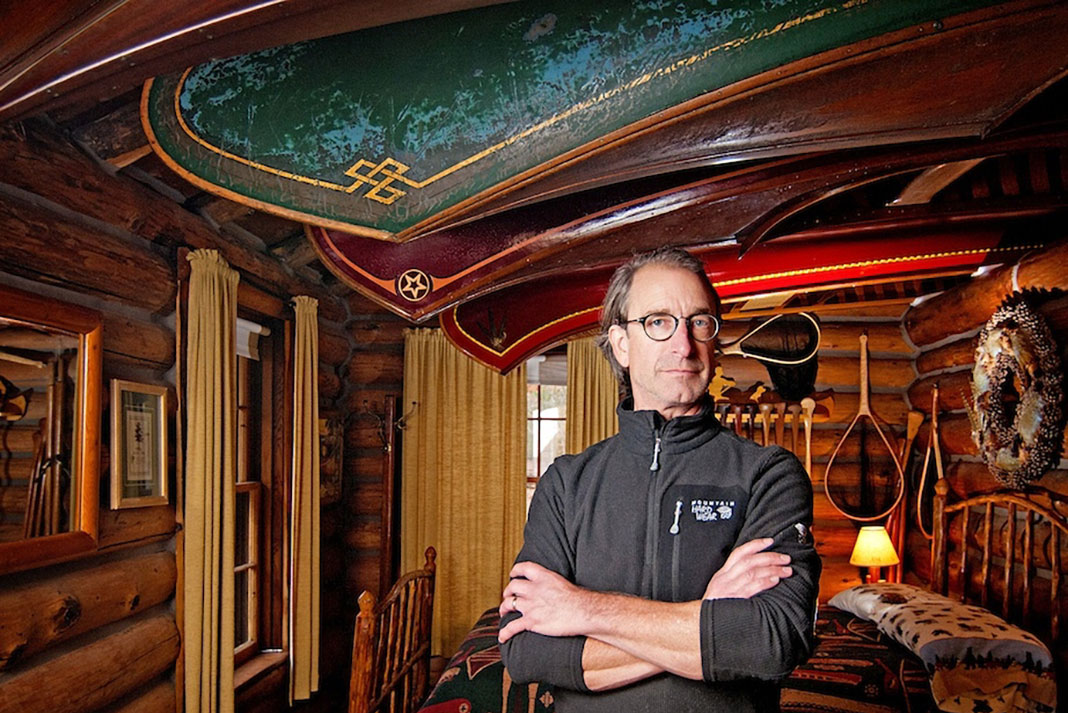
WCHA is made up of antique wood canoe enthusiasts, some of whom are collectors, though the membership is mainly comprised of folks that have one or more wood canoes that they intend to restore or enjoy paddling. The organization hosts its 35th national assembly this year at Paul Smith’s College in the Adirondacks. Drawing 300 to 400 people and their canoes every year, it’s the largest gathering of its kind in North America.
Kelly joined WCHA in 1994 and was elected president in 2009. The challenge today, he says, is getting paddlers interested in the old-world beauty, lore and poetry of wood canoes, when the attention is elsewhere.
“It’s a challenge trying to think of what we can do to get people who are doing the same thing in plastic and Kevlar, into wood canoes and out on the water,” says Kelly. “The on-water experience in wood is unsurpassed.”
Collection got its start on a no-motor lake
Kelly’s fascination with antique canoes developed in 1994 after learning he could not have a motorboat on the lake where he and his wife have their cottage. He had been looking for a vintage Chris-Craft runabout and shifted to considering a wood and canvas canoe to compliment the 1933 hand-crafted log cabin on the property.
His first was a 16-foot Old Town OTCA, built in 1963. It cost $800 and needed some work.
“It was nice and had a painted design on it, but I decided to repaint it,” Kelly says. “I went to put it up on the cabin wall for winter storage and thought it looked pretty nice; why not leave that one up there and get a second one to use.
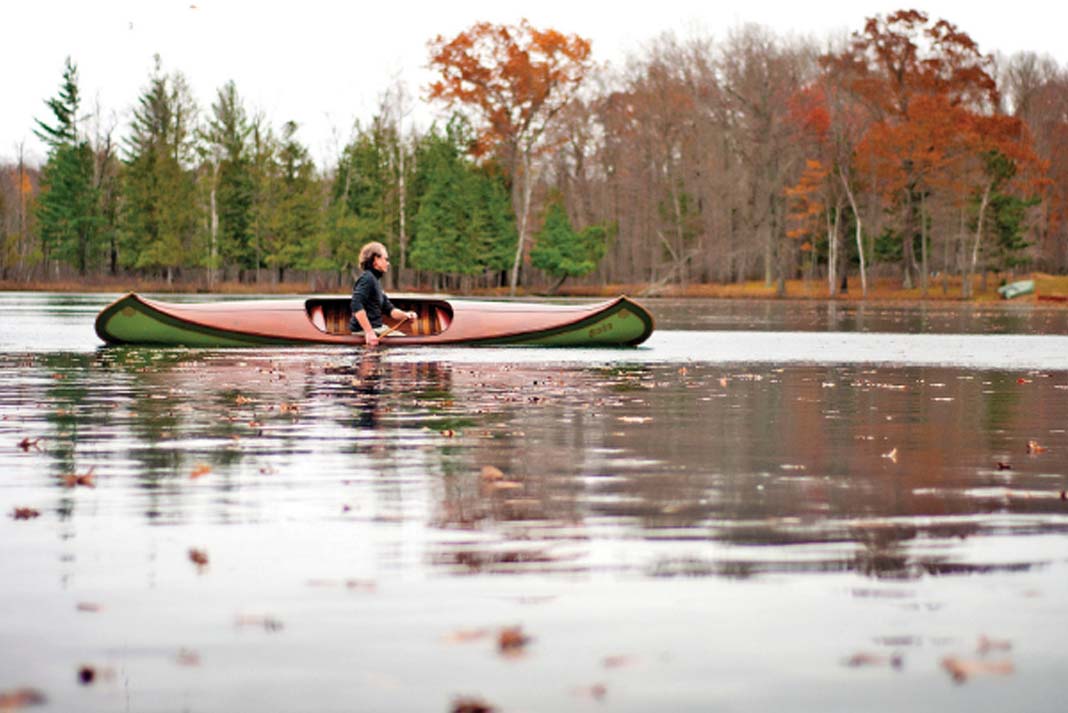
“I ended up finding a few others, mostly that needed repair, but it wasn’t very long before I had six canoes,” he adds.
“About a year after I got that first one, I realized I liked the look of the long decked courting canoe,” says Kelly, the type with the graceful, ornate designs and long, wooden decks that had no functional purpose other than style, and to create a more intimate space for turn-of-the-century couples. “I didn’t think I’d ever find one so I commissioned a builder who had an old mold and had him build me a replica of a Charles River Torpedo, a 1915- to 1920-era canoe.”
Kelly still owns that courting canoe along with 16 others, three or four of which will be displayed at the Canadian Canoe Museum in Peterborough, Ontario, starting in April when the museum opens a yearlong special exhibition called “Canoes and Romance.”
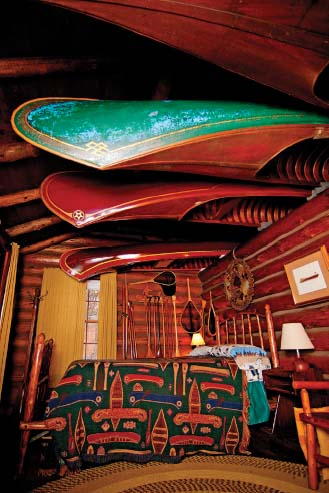
“We have gramophones, postcards, posters and great movie clips,” says John Summers, the museum’s general manager. “We have covered bigger themes in the past, such as the fur trade and exploration—this will be the pop culture of canoeing on display.
“Ken’s canoes are beautiful and courting canoes are a beautiful stage in canoeing. The flourish of the Charles River scene is a relatively small part of canoeing history, but it’s a fascinating part,” he adds.
Kelly’s wife agrees to be courted by canoe—once in a while
For her part, Kelly’s wife, Mary Reed Kelly, has long known of her husband’s penchant for collecting things. She tolerates it in good humor but does not consider herself a paddler, venturing out on the water only occasionally. Before canoes, she says, there were antique watches, sports cars and furniture. Kelly is also a master-gardener and a wine collector.
“He loves the idea of having beautiful things,” Reed Kelly says. “Ken always tries to make sure they are in the best shape they can be. He takes great pride in being able to say: ‘I took care of this.’”
“His specialty is courting canoes—that’s okay with me, once in a while,” Reed Kelly says wryly.
“She is happy to go for a ride occasionally and sit in the position that a woman would when being courted and let me paddle her around,” Kelly says chuckling, okay with the fact he often plays the role of lonely courtesan.
On his own time, Kelly enjoys paddling for recreation at the cottage and with other WCHA Michigan chapter members, who gather for weekends on different rivers or lakes each year. He has recently taken to developing his freestyle paddling skills.
Kelly’s collection includes, among others, a 1916 Peterborough canoe that hangs from the ceiling of his cottage. That’s where his best canoes are displayed amid a flood of courting-era memorabilia. It is where his 1915 H.B. Arnold canoe hangs over the door to the porch. There are also classic Old Town canoes, a 1930’s Carleton, a 1920’s E.M. White and a B.N. Morris, all of which were built in Maine.
Morris is considered by many to be one of the finest wood and canvas canoe builders. Kelly’s newest addition at the cottage is a restored 18-foot B.N. Morris that was built in 1918 for the canals of Belle Isle, the Detroit, Michigan island park on the Detroit River. The canoe’s sweeping lines and graphics convey the genteel nature of the era long past.
Future plans for the collection
Having 22 canoes does present logistical issues, Kelly says. Storage is one, as is the expense of having them restored. Sometimes he will sell one or more to make room for another he has found.
“The phase I am in now is that it has to be really special for me to add another, and I can’t do that unless I get rid of one,” he says.
Kelly admits he is looking for a very special Peterborough canoe, a 1904 Comfort-Craft model, commonly known as “The Girling Canoe”—just guess why.
A modern-day man with vintage tastes, Kelly views courting canoes as a vintage unmatched. And as with fine wines, if one picks well, they only get better with time.
Howard Meyerson is an award-winning outdoor writer and avid paddler from Michigan. He enjoyed paddling one of Ken Kelly’s antique canoes in 2012 on a trip down Michigan’s Au Sable River.
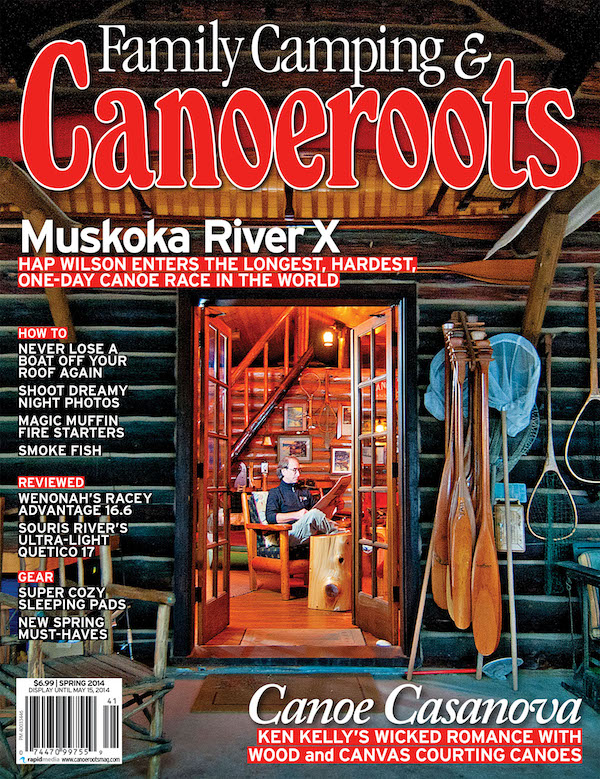 This article originally appeared in the Spring 2014 issue of Canoeroots. Subscribe to Paddling Magazine and get 25 years of digital magazine archives including our legacy titles: Rapid, Adventure Kayak and Canoeroots.
This article originally appeared in the Spring 2014 issue of Canoeroots. Subscribe to Paddling Magazine and get 25 years of digital magazine archives including our legacy titles: Rapid, Adventure Kayak and Canoeroots.Canoe collector Ken Kelly poses in front of a few of his prized pleasure craft. | Feature photo: Judith Strieby-Raska



